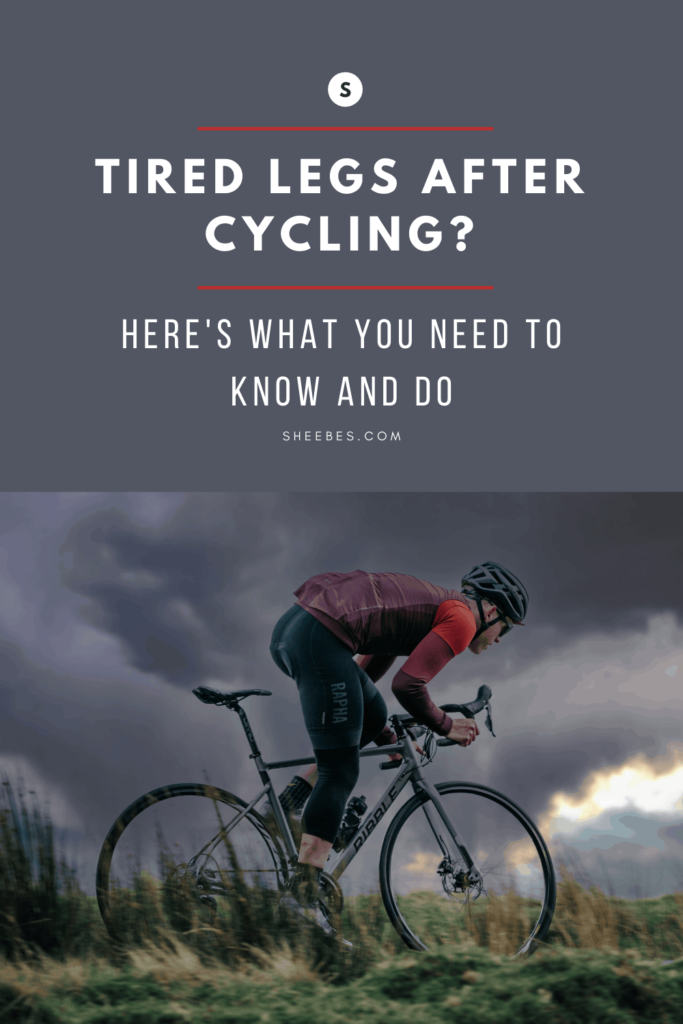“Why are my legs so tired after cycling?”
Feeling tired after cycling and having heavy legs after cycling isn’t unusual when you’ve worked—or maybe even overworked—your muscles.
So what should you do next? And how can you stop feeling so tired after cycling?
That’s what we’ll dig into here in this post. We’ll talk about the biggest reasons why you have tired legs after cycling and how you can get your legs back.
Let’s get started.

Whether you’re a runner looking for running tips or a cyclist searching for cycling advice, this site is here to help you elevate your fitness game.
Affiliate Disclosure: I’m here to help you grow as a rider and runner. So to keep things running smoothly and the content free, I participate in the Amazon Services program and select affiliate networks. So, when you click on those affiliate links, I earn a small commission at no extra cost to you.
THE BIGGEST REASONS WHY YOU HAVE TIRED LEGS AFTER CYCLING
- Pushing yourself too hard too soon.
- Finishing a bike race.
- You’re a cyclist over 40 (aka, a masters cyclist).
- Or, you did a long bike ride (If you did a long bike ride, you’ll want to head over to this post what to do after a long bike ride.)
Let’s have a closer look at the different scenarios that lead to tired legs after cycling and what you need to do to recover.

Tired, heavy legs after cycling? You may be pushing yourself too hard too soon
It’s easy to tack on too many miles or do too much intensity (such as cycling intervals) in a week because we don’t feel like we need to take a break—until our body tells us otherwise through heavy, tired legs from cycling.
Have you ramped up your biking mileage by more than 10 to 20% every week?
Your body likes gradual increases in your cycling mileage because this steady but progressive pace helps you adapt to more mileage while avoiding injury and overtraining.
If you’ve had a steep increase in your mileage—more than 10 to 20% each week—you’re probably due for a rest day or week.
Take a day off cycling, or reduce your mileage by at least 30% for a week before resuming your cycling routine.
And remember, your body needs time to adapt to new workloads, so you only need to add 10 to 20% to your weekly mileage total.
Have you increased the intensity of your bike rides with more days of interval training?
And the day after your interval or high-intensity rides, do you follow it with a day of easier bike rides?
If you don’t, you’re not giving yourself enough time to recover from your hard bike rides, and you’ll have cycling fatigue that will linger.
You’ll get faster on your bike with interval training and when you rest. Your muscles need to absorb and adapt to the interval training you did, so the day after a demanding bike ride should be either a rest day (no cycling) or a cycling recovery ride.
A cycling recovery ride is an easy conversation ride that lasts anywhere from 30 to 40 minutes, clears lactic acid from your muscles, and increases blood flow to your muscles to promote recovery.
Do you have at least one day of no cycling to rest?
Cycling stresses your body because it breaks down your muscles, and if you continue cycling and stressing your body without rest, you’ll eventually burn out*, get injured, or overtrain.
Schedule at least one day of no cycling to recharge and boost your cycling motivation
*This can manifest as cycling fatigue, and if you have tiredness that you can’t shake off in a few days, then head over to read more about the cycling fatigue symptoms.

Finishing a bike race can lead to heavy legs after cycling
We push ourselves harder when pitted against other racers, the adrenaline gets going, and we dig a little deeper in a racing environment.
You’ll feel the full effects of racing—sore legs after cycling—a day or two after a bike race.
WHAT TO DO AFTER CYCLING A RACE
If you’ve completed a bike race and have heavy legs after cycling, eat carbs and protein, and do a cycling recovery ride or a gentle walk to get the blood moving.
Carbs 1. When you cycle, your body depletes its glycogen (energy) stores, and you’ll need to replenish the glycogen you’ve used by eating carbs to recover and perform well in future workouts.
After a bike race, aim for ~1.0–1.2 grams per kilograms per hour for 4 to 6 hours to rebuild your energy stores.
Protein 2. Your muscles are made up of proteins, and cycling can damage these muscle fibers. But eating protein after a bike race or any cycling workout gives your body the amino acids it needs to repair these fibers and build new muscle tissue.
Consume high-quality protein sources of roughly ~0.25–0.3 grams per kilogram per body weight to give you amino acids to build and repair muscle tissue.
Don’t want to do the math to figure out the exact amount of carbs and protein you need to consume? This recovery mix will help you jumpstart your recovery if you’re looking for an on-the-go option.

You may need more time to recover sore legs after cycling if you’re over 40
If you’re a cyclist over 40 (aka, a masters cyclist), you may need more time to recover your sore legs after cycling.
At the moment, it’s unclear whether age is the only factor in slower recovery or if it is because of life circumstances as you get older such as sleeping less or more stress.
So how should you balance your cycling and recovery along with everything else?
- Have a purpose for each of your bike rides. Maybe one day you’ll focus on interval training for speed, and the next day you’ll focus on doing a longer bike ride for endurance. Whatever bike ride you choose to do, take note of how you feel the day after to see if you’ve overextended yourself. Doing more isn’t always better if you can’t recover, absorb and adapt to the workouts you do.
- Choose recovery and rest over a ride, especially when you haven’t slept well or feel a niggle of pain. Recovery may be a few yoga moves, taking your dog for a walk, or putting your feet up to watch a movie—whatever it is, choose recovery to help you calm your body and mind.
- Try a sleep tracker to help you discover how much and how well you’ve been sleeping, your resting heart rate, and more. We’ve all heard it before—sleep is vital—and it’s even more so if you’re an active person. Not getting enough zzz’s will make you more irritable and stressed, you’ll find it hard to focus, and you’ll delay your recovery.
We’ve talked about the biggest reasons why you have tired legs after cycling and how to adjust your plan when you have sore legs after cycling.
But the cycling tips don’t end here.
What you do right after your bike ride can also influence how sore you’ll feel the days after your bike ride.
And it’s why I’ve created a timeline of what to do after cycling to take the guesswork out of your cycling recovery, so grab the download today!

Sources